|
Yarra
Valley, part 3
The
wines of De
Bortoli
De Bortoli Yarra Valley, Pinnacle Lane, Dixons Creek, VIC 3775, Australia
Tel: 03 5965 2271 Fax: 03 5965 2442
E-mail: yarra@debortoli.com.au
Wesbite: www.debortoli.com.au
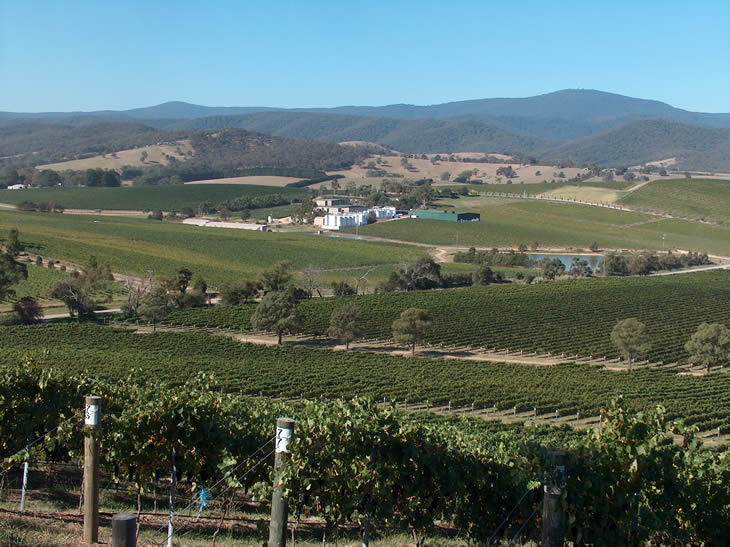
The
De Bortoli vineyards and winery
De Bortoli’s Steve Webber (below) is an
interesting guy. In 1989 he married Leanne De Bortoli, one of the family, and they set out to establish a premium wine operation in
the Yarra Valley, where he’s now chief winemaker. And these days
De Bortoli are on a bit of a roll.
Most readers will be familiar with the name De Bortoli
through its famous sweet wine, Noble 1. This isn’t from the
Yarra, but rather De Bortoli’s home in New South Wales and
specifically the Griffith region, where the company was founded in
the 1920s. For those with a historical bent, there’s a timeline
of De Bortoli’s history on their website.
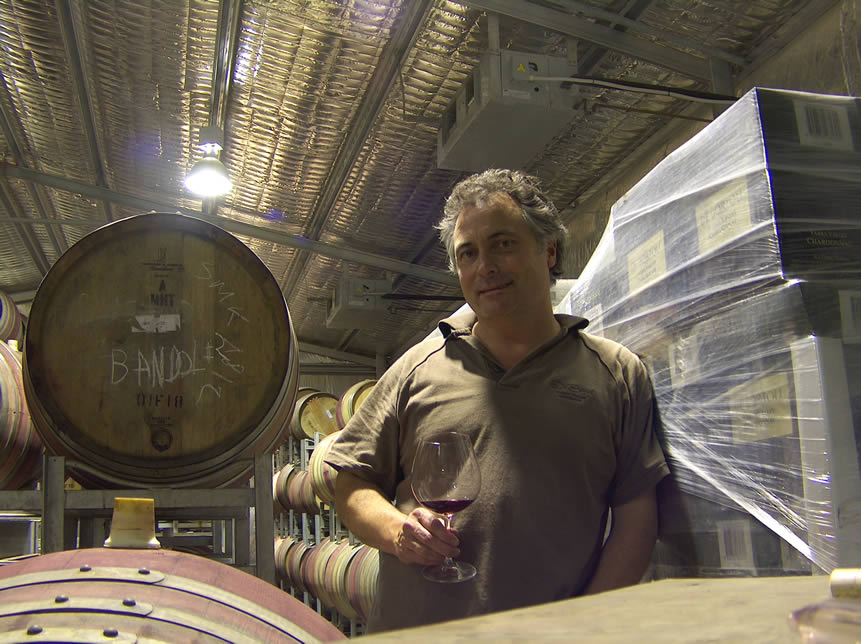
The three De Bortoli brothers run things: one is the
MD, one the viticulturalist and one the export director. The
inaugural vintage of Noble One, the 1982, still holds up, even
though more recent vintages are thought to be better wines. But
here our focus is on the excellent wines that De Bortoli are
currently producing from their Yarra Valley operation.
It seems that many of us at some stage in our lives
will have a period where we go through some sort of mid-life
crisis—a time where we question everything, introspect for a
while, and then realign our priorities in the light of our new
found self-knowledge. Either that, or we do the more typically
male thing of going out and buying ourselves a sports car or fast
bike. I guess it depends on your personality. Perhaps Steve Webber
has recently undergone such a transition: his winemaking
philosophy certainly seems to have shifted in recent years.
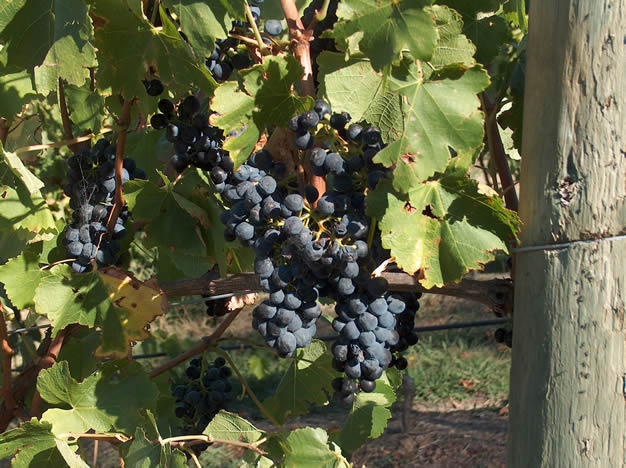
Shiraz
Indeed, much of De Bortoli’s current success is down
to the relatively new-found excellence of its Yarra wines. ‘I
woke up to smell the roses five years ago’, says Webber, ‘and
decided to make changes.’ Webber had spent time in Europe, and
this led to a change in philosophy, not just in the style of the
wines, but also at a deeper level, with an interest in
sustainability and preserving the vineyards for his children.
‘We went through all the vineyards and graded their
potential A, B or C. We moved a tremendous amount to organics, and
we are pretty strict with what we do in those blocks.
We also moved a lot of rootstock to 101/44, and changed the
row orientation in many cases to get less sun,’ explains Webber.
‘We are looking for neutrality in the wine: we don’t want so
much ‘sunshine’; we’d rather have the soil and vineyard
characteristics’.
There’s also been a move to cane pruning with shoot
thinning, and hand sorting at harvest to get the most perfect
fruit. There’s also a move towards minimal herbicide use.
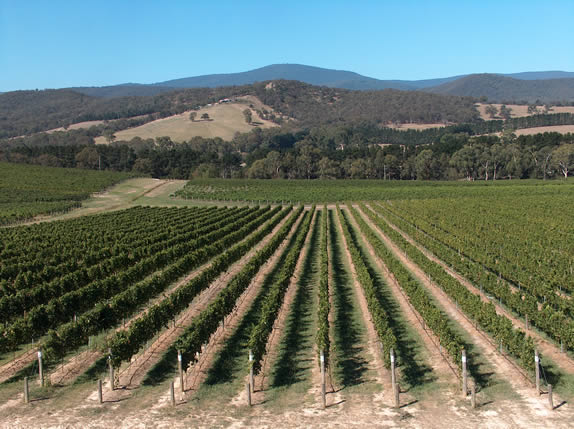
In the winery, lots of use is made of natural
fermentation: none of the Pinot Noirs are inoculated with cultured
yeasts. There’s a move away from new oak, too. Webber says he
would like to ferment all his whites in old oak: ‘old oak gives
great texture to all things’. Each year he buys 200 new
barriques, uses them for $12 wines and then brings them back for
the premium wines. The Reserve Chardonnay, for example, sees no
new oak.
We tried through some barrel samples, which were
looking really interesting. These included a sparkling base wine
in barrel with great acidity (described by Steve as ‘Krug base’),
a Chardonnay that was finishing its ferment, a Sauvignon in old
oak (Steve says he’s ‘unbelievably excited about Sauvignon at
the moment’), and a 2005 Phi Chardonnay from high altitude
vineyards that’s a joint venture and which is bright, expressive
and shows lovely freshness, spice and toastiness. A 2005 Shiraz
Viognier component is vivid and delicious, and then, most
interesting of all, is a barrel labelled ‘Cornas’. It’s a
Shiraz from a really good vineyard that undergoes whole bunch
fermentation, and has magical, spicy fruit with lovely structure.
Then it was on to tasting some bottled wines. I was
really impressed across the board, and not least by the quality of
the new Sero range: these are relatively inexpensive wines from
500 acres of vineyards in Victoria’s King Valley, and they
over-deliver substantially.
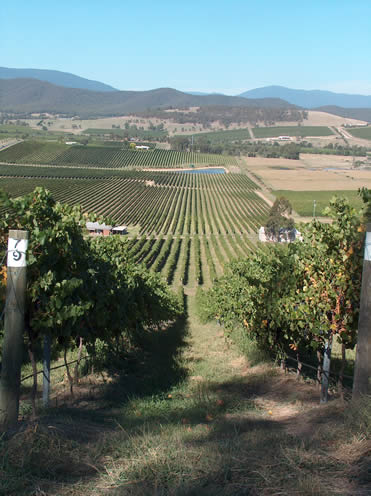 De
Bortoli Reserve Chardonnay 2004 De
Bortoli Reserve Chardonnay 2004
From a single vineyard planted in 1976. Amazing rich, open,
complex nose. Lots of rich, melony fruit here with some nutty oak.
The palate is rich and bold and generous, with some minerality.
Fantastic stuff. Very good/excellent 92/100
De Bortoli Reserve Chardonnay 2005
Some fresh minerality on the nose, which is complex and broad
but still tight. The palate is tight and intense with some
minerality. Nicely complex. Very good/excellent 92/100
De
Bortoli Reserve Pinot Noir 2004
Utterly remarkably, Steve Webber says he picked this at 11.8
degrees Baume. It has a sweet dark cherry nose that’s quite
forward and aromatic, with some earthiness in the background. The
palate is smooth and elegant with dark fruits hiding a fair bit of
structure. Very good/excellent 93/100
De
Bortoli Reserve Release Cabernet Sauvignon 2005
Massively structured and tannic. A wonderful Bordeaux-styled
wine.
De
Bortoli Gulf Station Pinot Noir Rosé 2005 Yarra
Look at the figures on this: pH 3.9 (very high) and TA 4 g/l
(very low). A salmon colour, this is lovely, soft, rich-textured
and subtle. Delicious stuff in a Provencale mould. Very good+
89/100
De
Bortoli Yarra Valley Sauvignon 2005
Lovely expressive nose: rich, full, but precise (only half
goes through malolactic fermentation). A really interesting palate
follows which has some richness and lovely aromatic complexity.
Very good/excellent 91/100
De Bortoli Shiraz Viognier 2004 Yarra Valley
Deep coloured. Beautifully
perfumed nose of smooth black fruits. Lovely vivid fruit on the
palate well supported by spicy structure. Very good/excellent
92/100
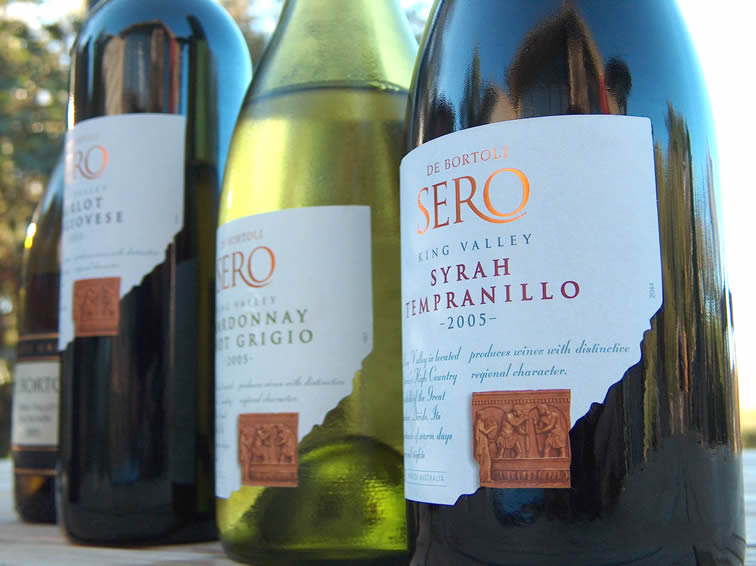
Sero
Chardonnay Pinot Gris 2005 King Valley
Nice fresh, clean, crisp fruity white. Very good+ 87/100
Sero
Merlot Sangiovese 2005 King Valley
The Sero reds are made by cutting the canes of about 30% of
bunches at 12 Baume: this simulates a ripasso (drying grapes on
mats after picking) process. Microoxygenation is also used. Lovely
ripe, pure fruit is evident, with a spicy savouriness and some
drying tannins on the finish. Very good+ 89/100
Sero
Syrah Tempranillo 2005 King Valley
Wonderful pure, sweet bright fruit nose showing vivid
blackcurrants and blackberries. There’s some freshness to the
fruit on the palate along with a savoury, spicy twist. Delicious
stuff. Very good/excellent 90/100 (Sold in UK supermarket
Sainsbury under the Windy Peak label)
Yarra series:
Wines tasted 03/06
Find
these wines with wine-searcher.com
Back
to top
|

